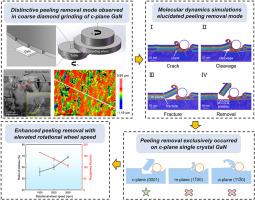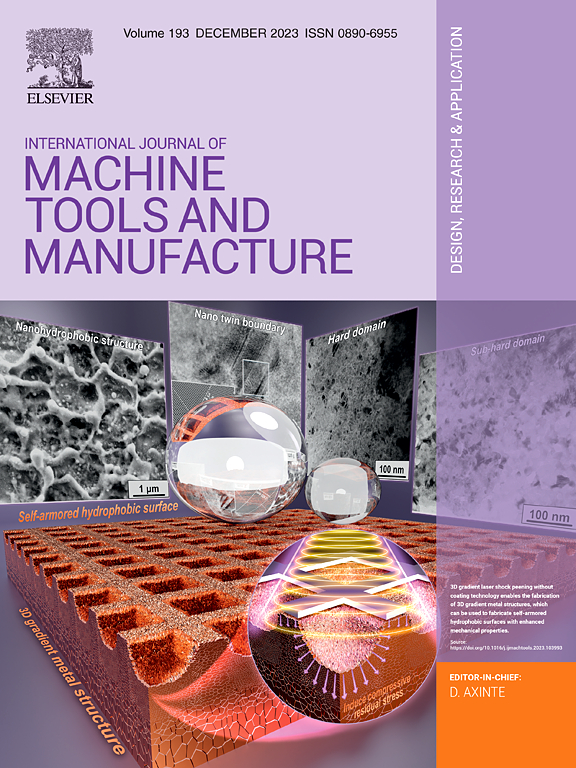金刚石磨削(0001)取向单晶氮化镓时的独特材料去除机制及其对脆性材料基底制造的影响
IF 18.8
1区 工程技术
Q1 ENGINEERING, MANUFACTURING
International Journal of Machine Tools & Manufacture
Pub Date : 2024-10-23
DOI:10.1016/j.ijmachtools.2024.104222
引用次数: 0
摘要
制造先进光电设备对单晶氮化镓(GaN)衬底的需求量很大。因此,开发针对这种难加工材料的高效加工技术至关重要,这反过来又要求对其变形机理有透彻的了解。在本研究中,系统地研究了金刚石磨削过程中(0001)取向单晶氮化镓的变形和去除特性。当使用目数为 2000 的相对较粗的金刚石磨料时,材料去除呈现出脆性模式,而当使用目数为 6000 的金刚石磨料时,则实现了韧性去除。在粗磨过程中,沿(0001)晶格面(c-平面)观察到了一种新的剥离现象,因为该晶体具有六方晶系结构,c-平面是理想的滑移/开裂平面。在材料去除过程中观察到的剥离现象与韧性机制中的纳米压痕相比,横向平面缺陷更容易在纳米划痕中产生的发现完全一致,表明切向磨削力的影响是显著的。采用较小的压痕/划痕模型进行分子动力学(MD)模拟,进一步证实了横向力在引发 c 平面上的平面缺陷方面所起的关键作用。此外,更大尺度的 MD 划痕模型证实了在 c 平面的变形过程中出现了剥离现象,在脆性体系中进行的划痕实验也证实了这一发现。相反,在 m 平面和 a 平面上则不存在这种剥离现象。作为对模拟的补充,还进行了专门设计的磨削实验,以经验证明剥离现象随着砂轮转速的提高而加剧。这种现象的加剧归因于与更高转速相关的切向磨削力的增加。这些发现有助于全面了解砂轮转速、切向磨削力和单晶氮化镓加工中观察到的剥离机制之间的复杂关系。本文章由计算机程序翻译,如有差异,请以英文原文为准。

A distinctive material removal mechanism in the diamond grinding of (0001)-oriented single crystal gallium nitride and its implications in substrate manufacturing of brittle materials
Single crystal gallium nitride (GaN) substrates are highly demanded for fabricating advanced optoelectronic devices. It is thus essential to develop high efficiency machining technologies for this difficult-to-machine material, which in turn necessitates a thorough understanding of its deformation mechanism. In this study, the deformation and removal characteristics of (0001)-oriented single crystal GaN involved in diamond grinding were systematically investigated. The material removal exhibited a brittle mode when using relatively coarse diamond abrasives of 2000 in mesh size, while ductile removal was achieved when diamond abrasives of 6000 in mesh size were utilized. A novel peeling phenomenon was observed along (0001) lattice plane (c-plane) in the coarse grinding, as the crystal has a hexagonal crystal structure with c-planes serving as the preferable slip/cracking planes. Peeling observed in material removal agrees well with the findings that lateral planar defects were prone to initiate in nanoscratching in comparison to nanoindentation in the ductile regime, indicating that the effect of tangential grinding force is significant. The application of Molecular dynamics (MD) simulations, employing smaller indentation/scratching models, provided additional confirmation of the crucial role played by lateral force in initiating planar defects on c-planes. Furthermore, larger-scale MD scratching models substantiated the occurrence of peeling in the deformation process on c-plane, a finding corroborated by scratching experiments conducted in the brittle regime. Conversely, such peeling is absent on m- and a-planes. Complementary to the simulations, specifically designed grinding experiments were conducted to empirically demonstrate that peeling phenomena were intensified with elevated rotational wheel speeds. This enhancement was attributed to the increased tangential grinding force associated with higher speeds. These findings contribute to a comprehensive understanding of the intricate relationship between rotational wheel speed, tangential grinding force, and the observed peeling mechanisms in the context of single crystal GaN machining.
求助全文
通过发布文献求助,成功后即可免费获取论文全文。
去求助
来源期刊
CiteScore
25.70
自引率
10.00%
发文量
66
审稿时长
18 days
期刊介绍:
The International Journal of Machine Tools and Manufacture is dedicated to advancing scientific comprehension of the fundamental mechanics involved in processes and machines utilized in the manufacturing of engineering components. While the primary focus is on metals, the journal also explores applications in composites, ceramics, and other structural or functional materials. The coverage includes a diverse range of topics:
- Essential mechanics of processes involving material removal, accretion, and deformation, encompassing solid, semi-solid, or particulate forms.
- Significant scientific advancements in existing or new processes and machines.
- In-depth characterization of workpiece materials (structure/surfaces) through advanced techniques (e.g., SEM, EDS, TEM, EBSD, AES, Raman spectroscopy) to unveil new phenomenological aspects governing manufacturing processes.
- Tool design, utilization, and comprehensive studies of failure mechanisms.
- Innovative concepts of machine tools, fixtures, and tool holders supported by modeling and demonstrations relevant to manufacturing processes within the journal's scope.
- Novel scientific contributions exploring interactions between the machine tool, control system, software design, and processes.
- Studies elucidating specific mechanisms governing niche processes (e.g., ultra-high precision, nano/atomic level manufacturing with either mechanical or non-mechanical "tools").
- Innovative approaches, underpinned by thorough scientific analysis, addressing emerging or breakthrough processes (e.g., bio-inspired manufacturing) and/or applications (e.g., ultra-high precision optics).

 求助内容:
求助内容: 应助结果提醒方式:
应助结果提醒方式:


